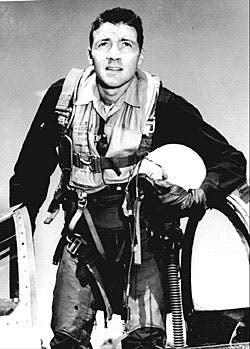John Boyd
The 40-Second Hero who revolutionized Air Warfare
Intro
John Boyd, to this day, is celebrated for his dominating fighter pilot techniques in the U.S Air Force in the 1950’s. Able to put his own strategy into practice, Boyd is often referred to as the greatest fighter pilot in American history. Although his own aerial prowess must be recognized, Boyd’s fame mostly stems from his innovative ideas that changed the course of air warfare. He was one of America’s most important and notable military strategists, an experienced fighter pilot responsible for the design of multiple fighter jets, a consultant to the Pentagon, and an intelligent theorist of aerial warfare. His ingenious ideas for aerial combat revolutionized the art of American war, allowing him to take place as one of America’s greatest heroes.
Despite being a renowned strategist of the twentieth century, John Boyd is a bit of a mysterious name, akin to another great military strategist, Chinese general Sun Tzu, because Boyd rarely published any of his theories and strategies. Instead, his legacies are felt in the strategies that live on today rather than in the words he put down to paper.2 Amid his various achievements, one of Boyd’s greatest strengths were his insightful briefings that he gave to his fellow fighter pilots at the Nellis Air Force Base. His self-confidence combined with his scientific approach to military strategy resounded in his briefings, which had a great impact on his peers.3
Like Sun Tzu, John Boyd approached warfare as something that could be codified, studied, and understood. Although he intuitively understood air combat, he believed that it could be scientifically understood, and his teachings often took the format of guides and manuals, many of which are still in use by the U.S. Air Force today. His eloquent teaching abilities, based on logical and rational scientific thinking, made John Boyd one of the Air Force’s greatest weapons.
You gotta challenge all assumptions. If you don’t, what is a doctrine on day one becomes dogma forever after.
– John Boyd[1]
On their shoulders
For millennia, great thinkers and scholars have been working to understand the quirks of the human mind. Today, we’re privileged to put their insights to work, helping organizations to reduce bias and create better outcomes.
Ideas
The Aerial Attack Study
While most fighter pilots viewed warfare as an art, Boyd had a different approach. Boyd strove to understand air combat as a science that could be codified. If it could be codified, it could be studied, and the Air Force could be more successful in their endeavors. He had a very practical mind, believing that to do was better than to be. He claimed that at some point, people would face a fork in the road and have to decide to be someone, or to do something. He advocated for doing something: “something for your country and for your Air Force and for yourself. If you decide you want to do something, you may not get promoted and you may not get the good assignments and you certainly will not be a favorite of your superiors. But you won’t have to compromise yourself. And your work might make a difference.” 4
Boyd’s work certainly did make a difference. Putting his scientific mind to the study of air combat, Boyd developed the “Aerial Attack Study”.5
The Aerial Attack Study was the first manual on air-to-air combat. It presented combat as a series of moves and countermoves. Similar to Isaac Newton’s third law of motion, that states that for every action there is an equal and opposite reaction, Boyd wanted his fellow fighter pilots to study the possible counter moves of their opponents after they had made an initial move. By analyzing all the potential counter attacks of their opponents, fighter pilots could make informed and intelligent decisions on how to proceed. This would make them better and quicker at responding, which would allow them to gain an advantage in the battlefield.5
The Aerial Attack Study is still in use by the U.S. Air Force today, and by other air forces around the globe.2 Although the study is based on air combat, it’s foundation can be applied as a strategy for our everyday decision-making. We live in a very chaotic world that is always laced with ambiguity and uncertainty. Grant Hammond, author of The Mind of War: John Boyd and American Security, writes in his book, “ambiguity is central to Boyd’s vision […]not something to be feared but something that is a given […] We never have complete and perfect information. The best way to succeed is to revel in ambiguity.”6 By understanding life as a series of moves and countermoves, we can better handle the uncertainty that is thrown our way instead of letting it throw us off our game. Boyd believed that this mental framework was relevant not only for aerial warfare, but for any manner of conflict, meaning it can be relevant to business and individuals today.
The OODA Loop and Rational Thinking
Similar to the rational approach outlined in the Aerial Attack Study, another of John Boyd’s greatest contributions to aerial warfare was the “OODA Loop” that he introduced in a number of briefings. OODA stands for “Observe, Orient, Decide, Act.”7 The OODA loop was supposed to help fighter pilots remain calm and rational in chaotic and confusing moments, and ensure that even in very challenging moments, they would be able to decide the best course of action.
The OODA Loop changed the way that fighter pilots approach battle but can also be useful whenever we face chaotic situations that require us to make decisions. Many of the biases that TDL explores are caused because humans deviate from rational thought processes, and keeping the OODA Loop in mind may help us make more informed decisions.
The first component of the loop, “Observe”, is Boyd emphasizing the need to acquire as much knowledge as possible in any given situation. The more knowledge we have, the better we can assess the best course of action. Part of Boyd’s observation was based on needing to sort out information that we are presented with, into what is important for our decision-making and what can be ignored.6 Since we are often bombarded with information, it is important to be able to sift through the white noise.
Next comes the “Orientation” part of the loop. Orientation was about connecting to reality, important in tumultuous situations that cause us to panic and make irrational choices. To orient oneself to reality, Boyd told fighter pilots they needed to assess what barriers that could interfere with their actions.6 Applying orientation to everyday life, orientation can mean that we inform ourselves about what obstacles we will face in trying to attain a goal, so that we are better prepared to overcome those obstacles when they are thrown our way.
Third in the loop was “Decide”. After acquiring all the possible information about a given situation, and assessing what barriers may prevent us from achieving our goal, we should have arrived in a position to make an informed and well-thought out decision on how to proceed.6 Although this part of the loop may seem self-evident, when we are in stressful situations, it can be difficult to be decisive, so this part of the loop reminds us that we need to be confident in what we choose to do – which we should be if we first observed and oriented.
Lastly, comes “Act”. Although the OODA loop is about creating mental models to help us make decisions, it ultimately has to accumulate into action.6 It is of no use to us to come up with a rational decision if we don’t follow through on it. That’s what this part of the loop is all about. Boyd claimed that “decisions without actions are pointless. Actions without decisions are reckless.” 1
Boyd believed that by teaching fighter pilots the OODA loop, they would be able to make smarter and quicker decisions in the battlefield, as they would become familiar with what to do in the face of uncertainty, allowing them to have an advantage over their opponents. It was called a loop because Boyd emphasized that this needed to be a constant process, with pilots constantly evaluating moves and countermoves.
The Energy-Maneuverability Theory
Boyd is often remembered for his energy-maneuverability (E-M) theory that revolutionized fighter combat. Boyd came up with E-M Theory along with mathematician Thomas Christie. It described a model for the performance of an aircraft, suggesting that an aircraft’s performance was based on the total of kinetic energies, including speed, thrust, drag and weight. By mathematically analyzing the potential energies, Boyd demonstrated that it was possible to predict the combat capabilities of different aircrafts. Pilots would be able to outsmart their opponents by a mathematical understanding of the potential of both their own aircraft, and their enemy’s.8
The E-M theory therefore allowed aircraft engineers and designers to be able to compare different models by predicting what trade-offs would occur between different forms of energies when the designs changed. The design tool allowed the Air Force to design aircrafts that were more efficient, and that had better maneuverability.9 Previously, fighter aircrafts had been designed to fly fast in a straight line.
The E-M theory was responsible for the design of the F-15 and F-16 F-18, aircrafts often described as the finest aircrafts of their type in the world.8 Boyd is known as the “father” of these aircrafts that have allowed the U.S Air Force to dominate the skies.
Historical Biography
John Boyd was born in the south short city of Eerie, in Pennsylvania in 1927.10 Before completing his high school diploma, Boyd enlisted in the Army Air Corps. He served in occupied Japan, as a swimming instructor, and then returned to the U.S. to complete his bachelor’s degree from the University of Iowa.10 Following the completion of his degree, Boyd became an officer in the Air Force.
Boyd began his fighter pilot career in Korea, in 1953, after being commissioned into the Air Force. He flew an F-86 Sabre, considered one of the most important aircrafts during the Korean War. Boyd was not credited with any kills, because his role was to be a wingman; supporting others by searching the horizons for any sign of trouble.11 His steady performance as a wingman was recognized and after his return, he was invited to the United States Air Force Weapons School, at the Nellis Air Force Base, one of the most prestigious fighter pilot schools.
After graduating from the weapons school, Boyd was asked to stay as an instructor, and it was during his time as an instructor at the Nellis Air Force Base that Boyd earned his nickname, “40-Second Boyd”. Boyd had made an open bet to all pilots that if they could beat him in a simulated air-to-air combat in under 40 seconds, he would give them $40. Legend has it that various students, cadre pilots (pilots trained in a new aircraft by the manufacturer), and marine and navy pilots all took the bet, but not one of them won.5
After six years at Nellis, Boyd went back to school for another degree. He earned a bachelor’s degree in industrial technology from the Georgia Institute of Technology. Boyd claimed that it was while studying for a test at Georgia Tech that he came up with his famous E-M Theory.5
Boyd retired from the air force in 1975, but still occasionally gave briefings and helped plan invasions, continuing to consult at the Pentagon.10 After having achieved various medals and awards throughout his career, at his retirement, Boyd received the Dr. Harold Brown Award.12 The Dr. Harold Brown Award is the most prestigious Air Force award that is given for achievement in science and technology.
Ultimately, Boyd unfortunately passed away in 1997, at the age of 70, due to colon cancer.
Boyd’s Wisdom
The OODA Loop was all about teaching fighter pilots how to deal with uncertainty. He stated that often, in confusing situations, we get stuck in how we think things ought to be, instead of staying focused on what is really happening. His advice was to “fight the enemy, not the terrain”13 as a reminder to stay focused on the situation at hand.
Boyd believed that mental frameworks like the OODA loop would lead to success because it could trigger an automatic thought-process that could beat out the opponent’s thought process. He also knew that uncertainty was oftentimes the cause of failure, urging his fellow fighter pilots to try and confuse the enemy. Boyd claimed, “in order to win, we should operate at a faster tempo or rhythm than our adversaries – or, better yet, get inside [the] adversary’s Observation-Orientation-Decision-Action time cycle or loop. Such activity will make us appear ambiguous and thereby generate confusion and disorder among our adversaries.”13 Like most of his strategies, this quote demonstrates that successful warfare is about understanding both one’s own moves and the opponent’s potential countermoves.
It is clear through his many years devoted to the U.S Air Force that Boyd had a lot of national pride and put his country first. He can be said to have put his needs to the side for the greater good of the country. He once said, “the most important thing in life is to be free to do things. There are only two ways to ensure that freedom – you can be rich or you can reduce your needs to zero.” 1
Additional sources
We’ve already mentioned one of the more well-known books about John Boyd, The Mind of War: John Boyd and American Security, written by Grant Hammond. Another great read is Boyd: The Fighter Pilot Who Changed the Art of War, written by Robert Coram. It takes a more biographical approach to Boyd’s story, compared to Hammond’s book, and includes more personal details about the man himself, describing him as an unsung hero.14
If you’re interested in a bit of a quirkier approach, and also want to know more about Chinese military strategist Sun Tzu, Chet Richards has written a book that examines how together, John Boyd and Sun Tzu would have hypothetically built the U.S military if they had the opportunity. It’s titled A Swift, Elusive Sword: What if Sun Tzu and John Boyd Did a National Defense Review?
The Films Media Group have also included John Boyd as one of the episodes in their series Legends of Air Power, which comes as no surprise since he is often referred to as America’s greatest fighter pilot. At only 24 minutes long, the video briefly touches on Boyd’s personal life, and his military service before moving on to his groundbreaking scientific developments.15
About the Author
The Decision Lab
The Decision Lab is a Canadian think-tank dedicated to democratizing behavioral science through research and analysis. We apply behavioral science to create social good in the public and private sectors.


